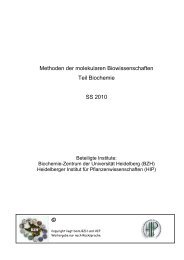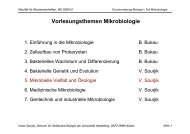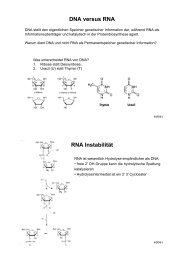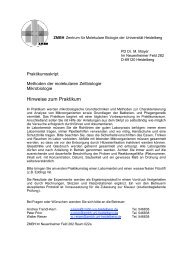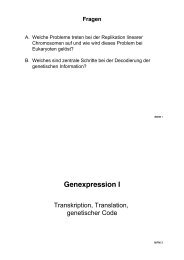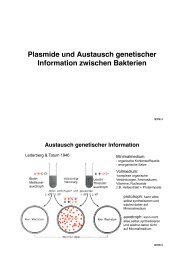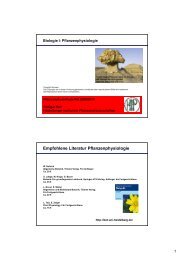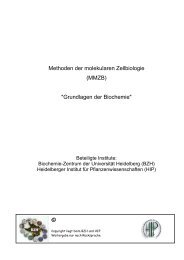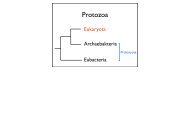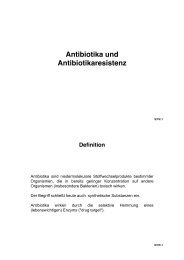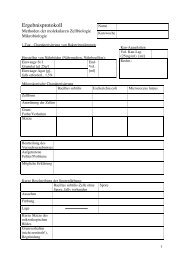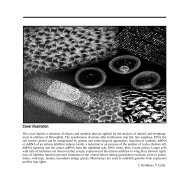ZMBH J.Bericht 2000 - Zentrum für Molekulare Biologie der ...
ZMBH J.Bericht 2000 - Zentrum für Molekulare Biologie der ...
ZMBH J.Bericht 2000 - Zentrum für Molekulare Biologie der ...
You also want an ePaper? Increase the reach of your titles
YUMPU automatically turns print PDFs into web optimized ePapers that Google loves.
vascular tone, protect neurons and muscles from ischemia,<br />
and are responsive to leptin. K ATP channels have<br />
an unusual octameric stoichiometry consisting of four<br />
pore-lining inward rectifier a α subunits (Kir6.1/6.2;<br />
two transmembrane segments) like other K+ channels,<br />
but also contain four regulatory sulphonylureabinding<br />
ß subunits (SUR1/2A/2B; probably seventeen<br />
transmembrane segments) that belong to the ATPbinding<br />
cassette (ABC) family of proteins.<br />
We found that only octameric K ATP channel complexes<br />
were capable of expressing on the cell surface, implying<br />
that quality control mechanisms must exist to prevent<br />
monomers and partial complexes from expressing<br />
on the cell surface. Surprisingly, we found that<br />
the primary quality control mechanism during K ATP<br />
assembly did not involve ER degradation or ER chaperones,<br />
but rather the exposure of an ER retention/<br />
retrieval signal (RKR) present in cytosolic domains<br />
of each subunit. Mutating the retention sequences did<br />
not affect protein levels, but allowed surface expression<br />
of monomers and partially assembled complexes,<br />
including improperly gated channel combinations. We<br />
further showed that the RKR trafficking signal was<br />
functional in a variety of eukaryotic cells including<br />
yeast, mammalian cells, and Xenopus oocytes. Interestingly,<br />
this RKR motif did not require proximity<br />
to the N- or C-terminus like all other known ER<br />
retention/retrieval signals and may, therefore, be more<br />
common. In conclusion, quality control during K ATP<br />
assembly is mediated by a short trafficking signal<br />
whose exposure reflects the assembly state of the<br />
channel. These results provide a clear example of how<br />
a trafficking checkpoint serves as an important quality<br />
control mechanism during the assembly of an ion<br />
channel complex. Furthermore, they identify a new<br />
ER retention/retrieval motif that could explain transient<br />
or permanent ER localization of many proteins.<br />
130<br />
Our current projects are designed to better define this<br />
new class of ER retention/retrieval signals, to extend<br />
the analysis of their role in assembly-dependent trafficking<br />
using K ATP channels as a model system, and<br />
to identify and characterize the molecular machinery<br />
that recognizes this class of signals.<br />
PUBLICATIONS<br />
Schwappach B., Stobrawa S., Hechenberger M., Steinmeyer<br />
K., and Jentsch T.J. (1998). Golgi Localization<br />
and functionally important domains in the NH 2 and<br />
COOH terminus of the yeast CLC putative chloride<br />
channel Gef1p. J. Biol. Chem. 273, 15110–15118.<br />
Zerangue N.*, Schwappach B.*, Jan Y.N., and Jan<br />
L.Y. (1999). A new ER trafficking signal regulates<br />
the subunit stoichiometry of plasma membrane K ATP<br />
channels. Neuron 22, 537-548 (*these authors contributed<br />
equally).<br />
Schwappach, B.*, Zerangue, N.* Jan Y.N., and Jan<br />
L.Y. (<strong>2000</strong>). Molecular basis for K ATP assembly: transmembrane<br />
interactions mediate association of a K +<br />
channel with an ABC transporter. Neuron 26, 155-167<br />
(*these authors contributed equally).<br />
STRUCTURE OF THE GROUP*<br />
E-mail: b.schwappach@zmbh.uni-heidelberg.de<br />
Group lea<strong>der</strong> Schwappach, Blanche, Dr.*<br />
Ph.D. student Yuan, Hebao, M.A.*<br />
Techn. assistant Metz, Jutta*<br />
* since July/August <strong>2000</strong><br />
Dominique Soldati<br />
Cell and Molecular Biology of the Obligate<br />
Intracellular Parasite Toxoplasma<br />
gondii<br />
Apicomplexan parasites are of enormous medical<br />
and veterinary significance, being responsible for a<br />
wide variety of diseases including malaria, toxoplasmosis,<br />
coccidiosis and cryptosporidiosis. Successful<br />
attachment and invasion of the host cells are key to<br />
the survival of these obligate intracellular parasites.<br />
T. gondii, the most ubiquitous of the Apicomplexa,<br />
has developed a remarkable ability to actively penetrate<br />
almost any nucleated cells from virtually all<br />
warm-blooded animals. Most invasive forms of the<br />
Apicomplexa share a common set of apical structures<br />
and exhibit an unusual form of substrate-dependent<br />
gliding motility as an adaptative mechanism to<br />
actively penetrate host cells. In absence of locomotive<br />
organelles such as cilia or flagella, the basic<br />
engine for gliding locomotion is the actin cytoskeleton<br />
and involves myosin(s) to generate the mechanochemical<br />
force along the actin filaments, allowing<br />
parasites to move at rates from 1 to 10 micrometers<br />
per second.<br />
Successive exocytosis of regulated compartments<br />
including rhoptries and micronemes is part of the<br />
invasion process. Micronemal proteins are apparently<br />
used for host-cell recognition, binding, and possibly<br />
motility, while rhoptry and dense granule proteins<br />
contribute to the parasitophorous vacuole formation<br />
and its remodeling into a metabolically active compartment.<br />
Release by micronemes occurs in the earliest<br />
phase of invasion, upon contact with the host cells<br />
and raise in intracellular Ca 2+ .<br />
Molecular motors, adhesins and proteases are among<br />
the distinct classes of genes coding for invasion factors.<br />
These genes are anticipated to be essential for<br />
the survival of these parasites and therefore the ability<br />
to conditionally turn on or off their expression is<br />
prerequisite for their in vivo studies.<br />
I. Myosins: molecular motors in Apicomplexa<br />
parasites<br />
Five myosins of T. gondii and three myosins of P. falciparum<br />
have been identified so far. These unconventional<br />
myosins are the foun<strong>der</strong>s of a novel phylogenetic<br />
and structural class of myosin (XIV), restricted<br />
to the Apicomplexa. Members of this class are small<br />
with molecular weights ranging between 90 and 125<br />
kDa and exhibit unusual structural features.<br />
Myosins have been implicated either genetically, biochemically<br />
or by cytolocalization in a variety of cellular<br />
functions. Three distinct forms of gliding characterize<br />
T. gondii motility: circular gliding, upright<br />
twirling, and helical rotation. Inhibitors of actin filaments<br />
(cytochalasin D) and myosin ATPase (butanedione<br />
monoxime) disrupted all three forms of motility.<br />
When applied on intracellular parasites, these<br />
inhibitors also interfere with proper parasite division.<br />
To determine whether one of these myosins functions<br />
as a motor in actin-based gliding motility and<br />
plays a role in cell replication, we have examined<br />
their stage-specific pattern of expression, subcellular<br />
distribution and biochemical properties.<br />
131



